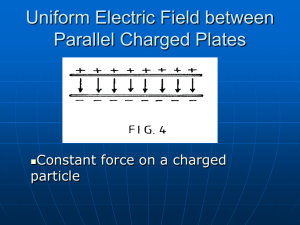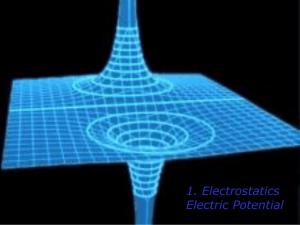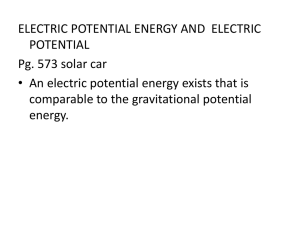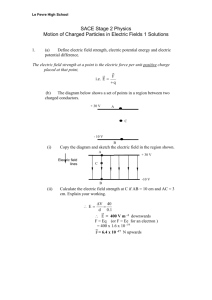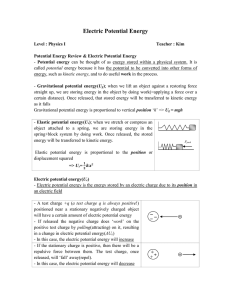Electric Potential Energy: Concepts & Calculations
advertisement
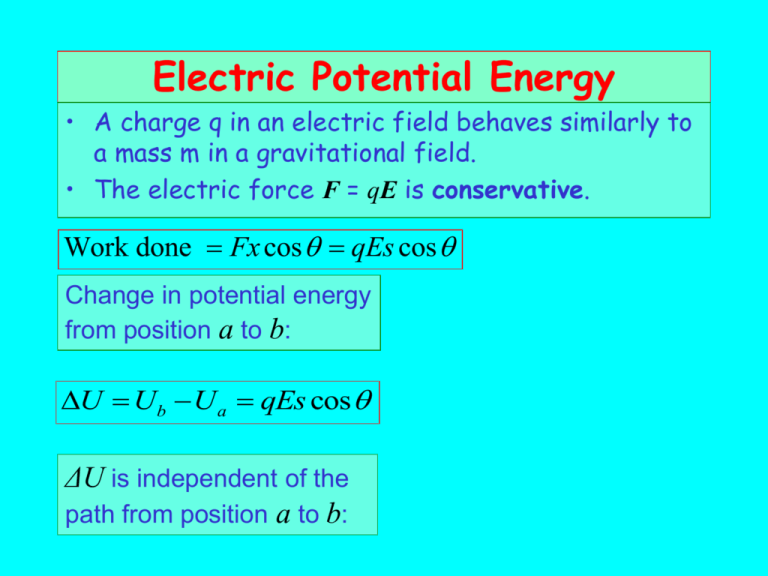
Electric Potential Energy • A charge q in an electric field behaves similarly to a mass m in a gravitational field. • The electric force F = qE is conservative. Work done Fx cos qEs cos Change in potential energy from position a to b: U U b U a qEs cos ΔU is independent of the path from position a to b: Electric Potential The electric field is related to how fast the potential is changing: For a constant electric field: Electric Potential and Potential Difference Ua Va (scalar quantity) Electric Potential: q - independen t of q Electric potential difference ΔV between a and b: - depends on position a Ub U a V Vb Va q q U E x x is along field lines q Electric Potential and Potential Energy U U b U a qVb Va Difference in potential energy Difference in electric potential • Electric potential V has units of Joules/Coulomb which is defined as a Volt: 1 Volt = 1 Joule/Coulomb • One Joule is the work done in moving one Coulomb of charge through a potential difference of one Volt. • Electric field has units of Newtons/Coulomb or Volts/meter: 1N/C = 1 J/(mC) = 1 V/m Analogy between Electric and Gravitational Fields q E m G d q m ΔU = qΔV = - qEd ΔU = - mgd The charge and mass lose potential energy and gain kinetic energy when they move in the direction of the field. Kinetic Energy of a Charge Accelerated by an Electric Field • The kinetic energy acquired by an electron or a proton accelerated through a potential difference of 1000 Volts: • Uba = qVba = (1.60 x 10-19 C)(1000 V) = 1.60 x 10-13 J = 1000 eV (electron volts) = 1 keV (kilo electron volt) One electron-volt (1 eV) is the kinetic energy gained by an elemental charge (electron or proton) when it is accelerated through a potential difference of one Volt. 1 eV = 1.6 x 10-19 J Electric Potential Energy: The Electron Volt • Suppose a point charge q is moved between two points a and b in space, where the electric potentials due to other charges are Va and Vb. • The change in potential energy is: ΔU = Ub – Ua = q(Vb – Va) = qVba • Unit = Electron Volt (eV): 1 eV = 1.6 x 10-19 J • e.g. a proton accelerated through a potential difference of 200 kV acquires a kinetic energy of • 200 keV (losing 200 keV of electric potential energy). Electric Potential due to Point Charge Electric Field: Q E k 2 (radially outward) r Using Calculus, it can be shown 1 1 V Vb Va kQ rb ra Convention: V=0 at infinite r Q V k (electric potential) r Electric Potential due to a Point Charge Electric potential at a distance r from a positive charge Q Electric potential at a distance r from a negative charge Q Equipotential Surfaces • Equipotential surfaces are surfaces of constant electric potential (just as lines of constant elevation on a topological map are lines of constant gravitational potential). • Equipotential surfaces are always perpendicular to the direction of the electric field. (just as the “fall line” is perpendicular to the contour lines on a topological map). Charged Parallel Plates Two Equal and Opposite Charges

